In this article, we’ll discuss about the beautiful foliage houseplant known as Wandering Jew. Below, I’m sharing with you 12 different types of tradescantia.
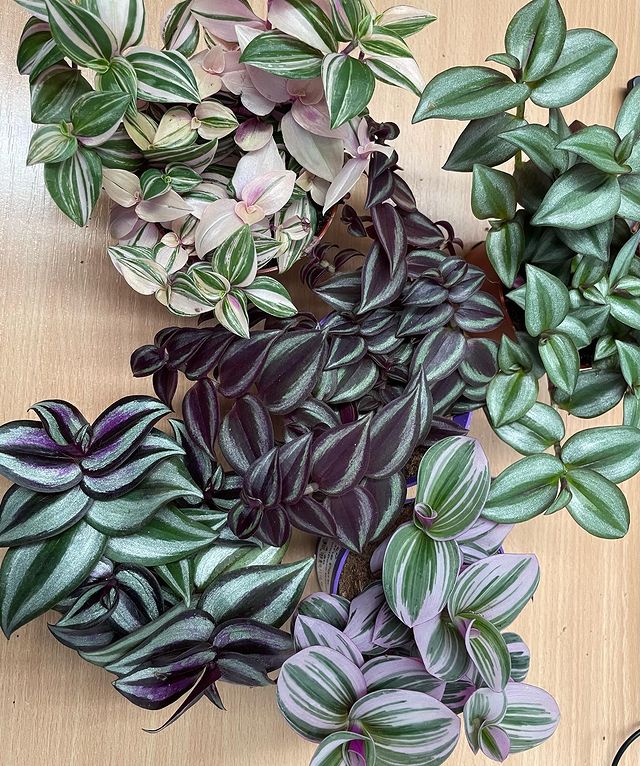
Common names: Inch plant, Spiderwort, Dayflower, Wandering Jew, Zebra plant, Oyster plant, Wandering Gypsy, Wandering Willy, Flowering inch plant, Purple Queen
Tradescantia genus includes 75 creeping, herbaceous perennial plants from the Commelinaceae family, native from southern Canada to South America, including northern Argentina and the West Indies.
The scientific name (Tradescantia) of these lovely, fast-growing, and easy-to-grow plants was given in honor of the English botanists, same-named father and son, John Tradescant.
What is Tradescantia?
Tradescantia plants have elongated, creeping, soft stems with elliptical leaves without a stalk that, depending on the variety, can be large or small, green, violet, purple, hairy, or dotted with yellow, silver, and creamy-white stripes. Most of the varieties have leaves with purple undersides.
Wandering jew plant blooms in summer with tiny, half-inch wide white, pink, or purple three-petaled flowers.
It grows densely and shrubby up to 10 inches in height, but its stems can extend up to two feet in length, making it an ideal plant for growing in hanging baskets or on window sills.
How to care for Tradescantia?
This modest plant does not require much care indeed! It is a dream plant for beginners and those who occasionally forget about their plants. However, if you want to grow a representative specimen and not just have a plant that manages to survive neglect, keep reading to find out all about desirable conditions for its successful cultivation.
Light
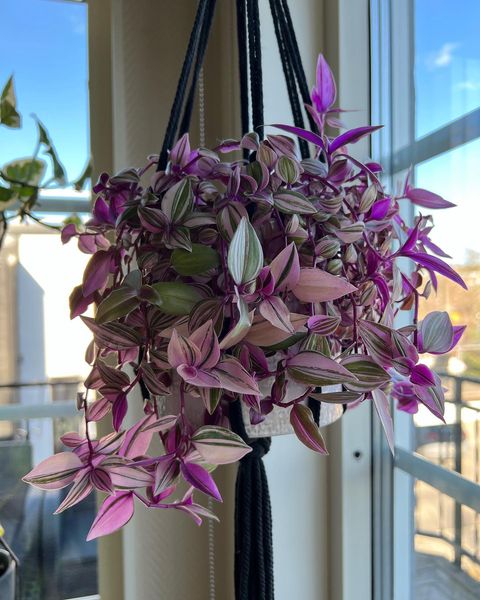
Wandering jew can grow in a sunny or partial shade depending on the variety.
Generally, the plant needs at least six hours of bright light daily, so you should place it next to the east or west window where it will get a lot of filtered light or even next to the south window shaded by a curtain during the hottest part of the day.
Proper lighting is one of the main factors in growing Wandering jew plants since only those that get enough light will show all their charm.
Plants that grow in low-light positions lose shape and become leggy, and in species with multicolored leaves, the variegated patterns are faintly noticeable or wholly lost.
Soil
Wandering Jew or Spiderwort can grow in almost any neutral or slightly acidic soil (pH 7) type as long as it is well-drained and porous. All the Inch plants like moist soil, but they are easier to cope with dry than soaked ones.
Therefore, to prevent dangerous moisture retention in the pot, you can add a small amount of sand or perlite to the commercial substrate to improve permeability.
Repotting
Tradescantia has no special requirements when it comes to transplanting. It can grow in a smaller or larger pot, and it does not mind root bonds and is usually transplanted only when it entirely outgrows the pot.
The best and most effective time to transplant is in the spring, but you can do this at any time as the plant recovers quickly from this procedure.
Water
All the Inch plants like moist soil, but they are easier to cope with soaked and dry soil. Also, since it is a drought-tolerant plant, it will not mind if you miss some watering because it is always better not to overdo it.
The standard regimen includes watering the plant twice a week, from spring to autumn, and once a month during the winter. However, it is better to check if the soil surface is dray at least two inches deep before the next watering!
Excessive watering or too long water retention due to poorly drained soil is a danger that this plant is difficult to cope with because it leads to root rot and the development of bacterial and fungal infections.
Temperature
The Inch plant comes from warm regions with mild winters, and its stems and delicate leaves cannot tolerate frost and cold temperatures of the continental climate.
The optimum temperature for growing Spiderwort plants is between 65 and 80 F.
Wandering jew can spend the summer outside, in the garden but don’t forget to bring it into the house in early fall as soon as the temperature drops below 50 F.
Humidity
The plant is adaptable and thrives in a standard home humid environment at 30 to 45%. Occasional spraying of the leaves with lukewarm stagnant water will refresh the plant, especially during the hottest day of summer.
Fertilizing
Top-dressing of Spiderwort plants is not obligatory. However, you can do it once a month from spring to autumn using a half diluted, general-purpose liquid fertilizer for houseplants.
Propagating
Not many houseplants can be propagated as easily and quickly as Tradescantia plants!
You can do it all year round, using root cuttings or dividing the existing plants. Whichever method you choose, it is a few weeks long process, and the effect is almost always 100%!
Stem Cutting in water

- You have to cut off the top parts of the stem three or more inches long! Then, cut immediately below the node at a 45-degree angle.
- Remove a few lower leaves from the stem and place the cuttings in a bowl of clean water.
- Keep them in a warm place out of the full sun but with a lot of bright indirect light.
- In seven to fifteen days, you will have newly rooted plants.
Stem cutting in soil
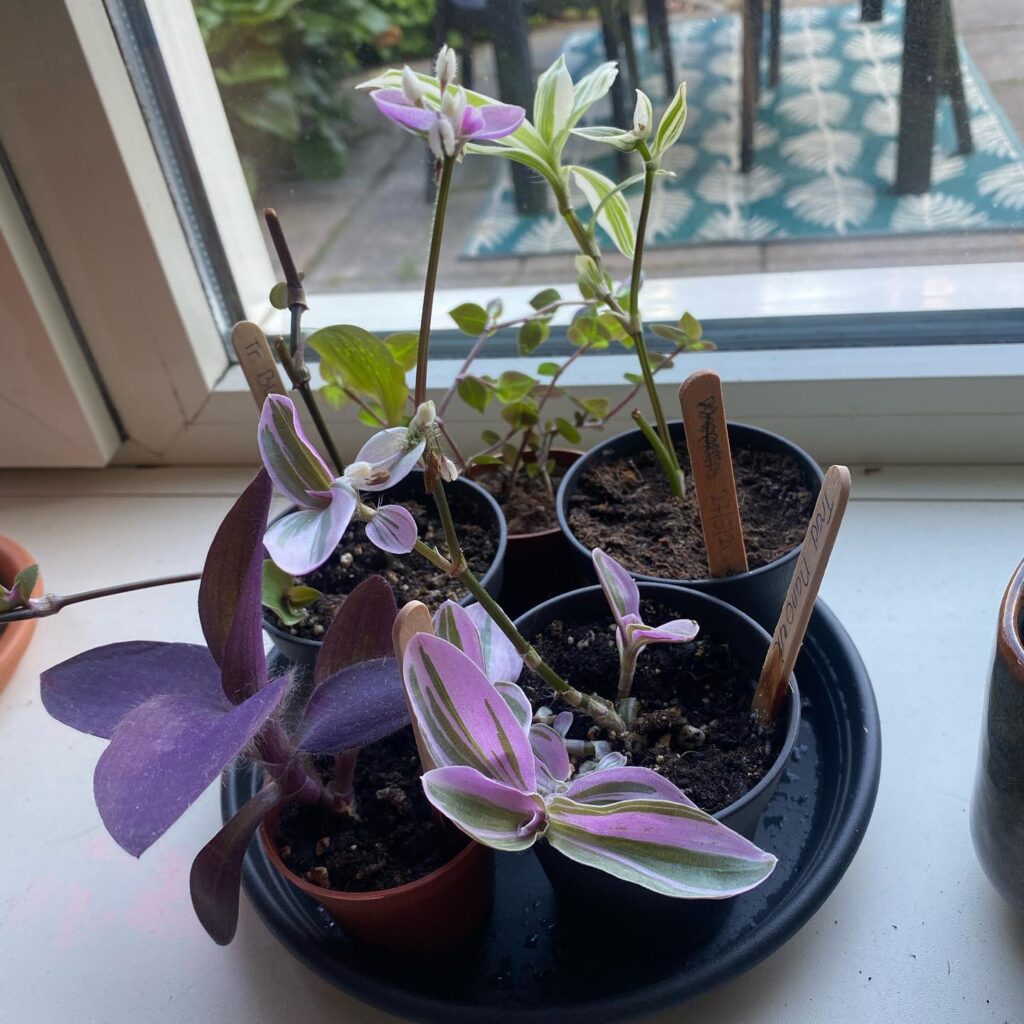
- Instead of water, you can stick the cuttings directly into the substrate next to the existing plant if it is not lush enough or in separate containers.
- Just stab the prepared cuttings without the lower set of leaves into the substrate to a depth of at least one inch.
- Keep the substrate relatively moist to accelerate rooting.
Plant division
- If the plant is large and dense enough and has already filled its pot, you can divide it into two or more plants.
- Carefully take out the plant and then slowly divide the roots. The stems are quite fragile and break easily, but you should not worry. If you break some of them when separating, you can use them as the cuttings and stab them next to the parent plant!
Types of Wandering Jew Plants
Chicago Botanic Garden, in a comparative study of Tradescantia cultivars (Plant evaluation notes), gave these plants a rating of four stars, thus confirming their high decorative value but also durability and simplicity with which they are grown.
We have selected 12 gorgeous types you can easily find on the market in many cultivars and varieties of Tradescantia plants.
But if you would like to learn more about different tradescantia types, here is a video with 28 Tradescantia varieties and species!
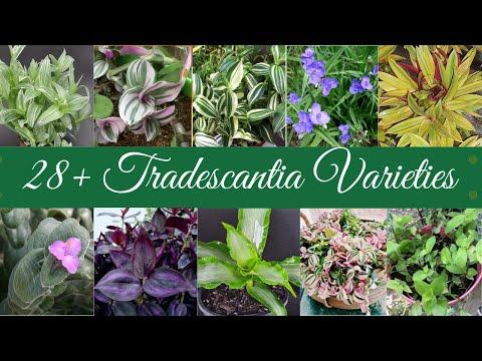
RELATED: How To Propagate Wandering Jew: What You Need To Know
1. Tradescantia Fluminensis
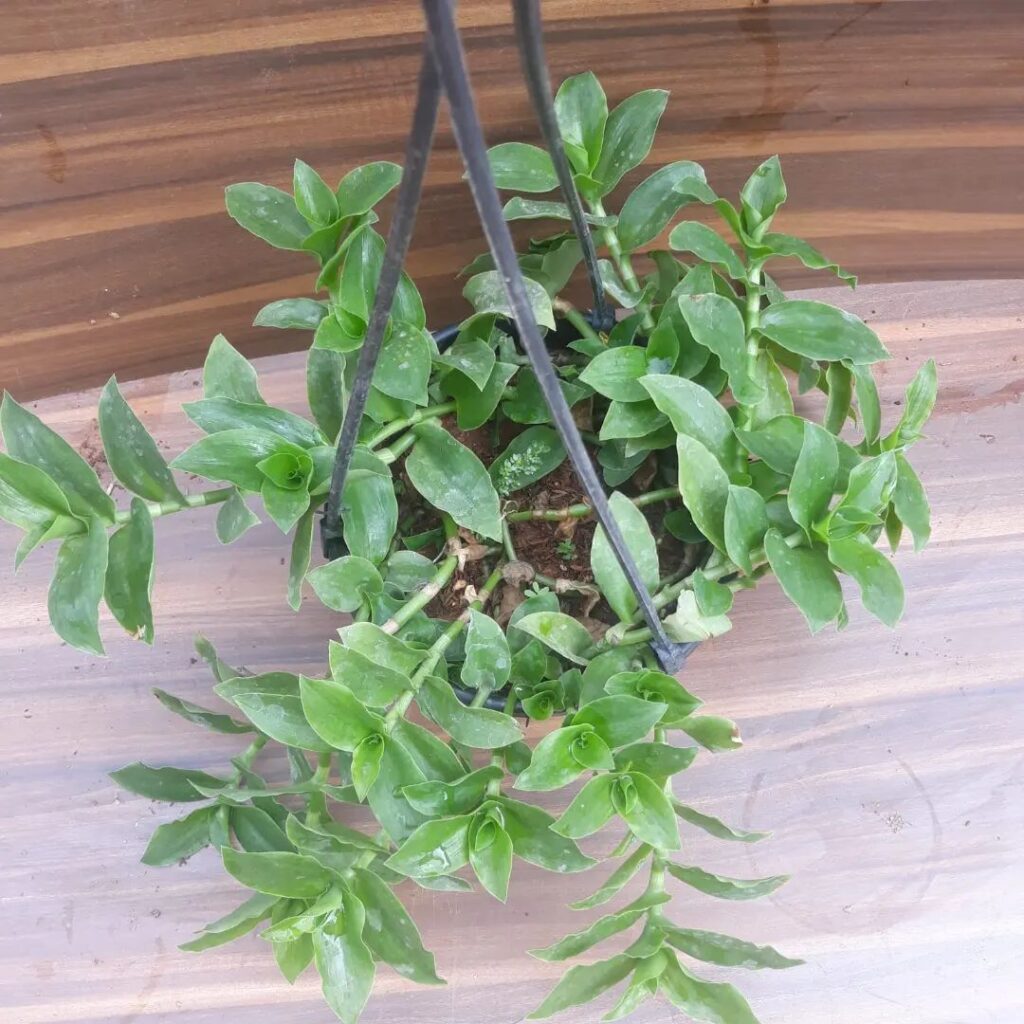
Tradescantia fluminensis is an endemic plant of the tropical rain forest of south-eastern Brazil, naturalized in other parts of the world, such as Australia, New Zealand, Russia, Italy, etc.
Tradescantia fluminensis is a green type of Tradescantia species with alternately arranged, thin, broad, oblong-lanceolate to oval leaves and dark green or flushed purple beneath.
They grow on fragile, waterly, light green stems up to two feet long and grow outside in warmer climates; it is a dense ground cover that is considered invasive since it roots around every node along the branches.
However, creeping stems with lush foliage and tiny, white flowers make Tradescantia fluminensis common indoor plants that look great in hanging baskets and do not require special care.
Yet, like many other types of Wandering jew plants, this plant does not tolerate direct sunlight because the thin leaves burn quickly.
Therefore, the ideal position for this plant is a space where it will get plenty of morning sun and shade for the rest of the day.
2. Tradescantia Pallida (Purple Heart)
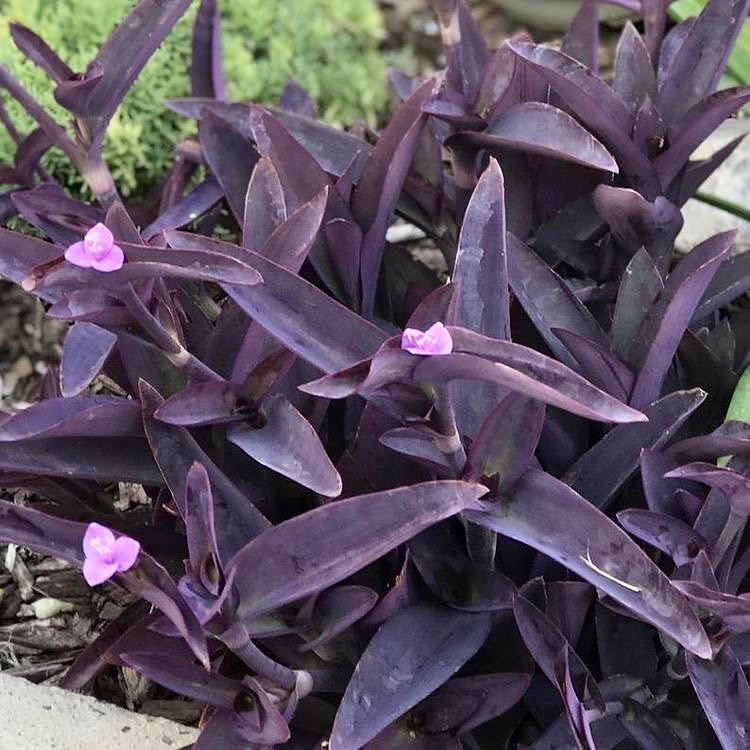
Tradescantia pallida or Purple Heart is a unique species of Wandering jew plants due to the elongated, fleshy, pointed, velvety, deep purple up to seven inches long leaves.
This delicate perennial native to northeastern Mexico is a low-growing creeper that thrives outdoors in climate zones 7 to 10.
You can grow Tradescantia pallida as a houseplant in a hanging basket next to the south window in colder regions because the plant has the most intense color when exposed to direct sunlight for several hours.
In partial shade, the plant acquires green undertones, loses lushness, and has elongated stems with only a few leaves.
The whole plant grows one foot in height but spreads much more in width so it can grow as a thick deep purple ground cover outdoors.
It blooms with purple or hot pink flowers in summer, creating a nice contrast to the darker leaves.
As garden plants, purple heart inch plants are invasive in climate zones 9 to 11; it is still not hard to control their spreading.
3. Tradescantia Nanouk (Tradescantia Albiflora Nanouk)
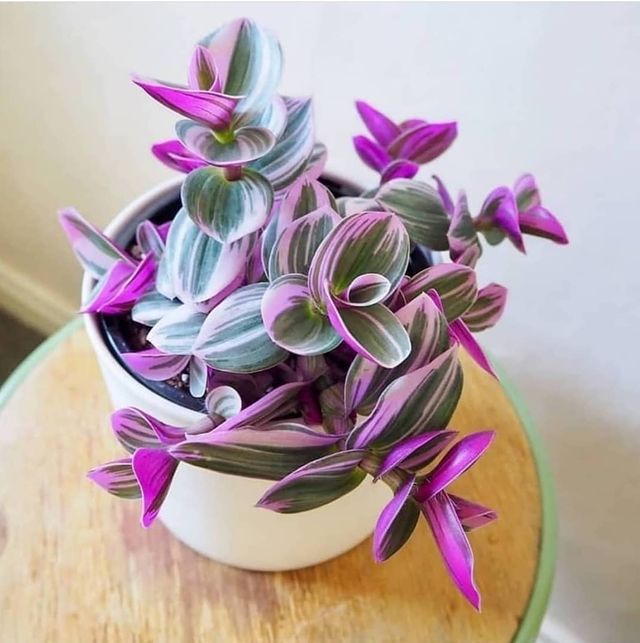
Tradescantia nanouk, also known as Fantasy Venice, is a new species of striped Inch plant created in the Netherlands. The popular novelty has gorgeous foliage with bright striped white-green and pink leaves and purple beneath, making it an extremely decorative and colorful houseplant.
The fast-growing and vigorous species of Inch plants, under suitable conditions, can grow into two or more feet long plants gracefully cascading over the edge of a hanging pot.
Although it can tolerate some direct sunlight, Tradescantia nanouk thrives best in bright indirect light next to east or west-facing windows.
Feel free to take it outside in the partial shade in the summer months and enjoy its beautiful variegated leaves, lovely trailing form, and three-petaled flowers in a white or purple color that develop from hot pink buds.
RELATED: Alocasia Dragon Scale: Your Must-Have Care, Propagation, and Watering Guide
4. Tradescantia Sillamontana White Velvet

Tradescantia sillamontana, commonly known as the White velvet inch plant, is a compact, shrubby species that grows 12 inches tall and 20 inches wide.
In our homes, this attractive herbaceous perennial of the Tradescantia family came from South America and southern Mexico, growing in arid and sunny areas.
It has opposite, oval, thick, almost succulent olive-green leaves covered with wooly silver-white hairs. The Sillamontana variegata with pink or white longitudinal stripes is rarer than its monochromatic cousin.

In warmer areas, climate zone 10 to 12, the White velvet wandering jew can grow as a ground cover, patio, or container plants outdoors exposed to full sun.
Due to its thick leaves that deposit water, this is a drought-tolerant plant that you often do not need to water. Moreover, the more direct sun and less water it gets, the more compact, denser, and hairy the plant becomes.
During the summer months, clusters of small purple-pink flowers with pronounced yellow stamens appear at the top of the stems.
5. Tradescantia Fluminensis Variegata
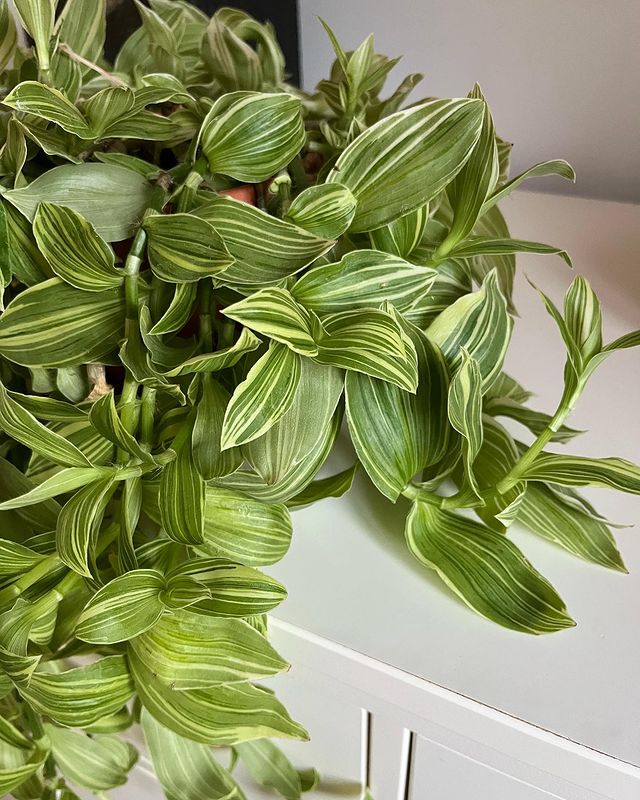
What makes this species of Wandering jew plant different from its relatives are the leaves that do not have a purple reverse!
Instead, the leaf’s surface is fresh light green with white uneven stripes or lines. Some leaves can have white as the dominant color depending on the light.
However, since the plants produce energy in green areas high in chlorophyll, this albino coloration is primarily sporadic, so most leaves have the same ratio of white and green.
With its fresh colors and triangular white flowers that appear during the summer, this two-foot-long potted creeper or ground cover garden plant illuminates the space, particularly when growing next to plants with darker leaves.
6. Tradescantia Zebrina (Red Gem)
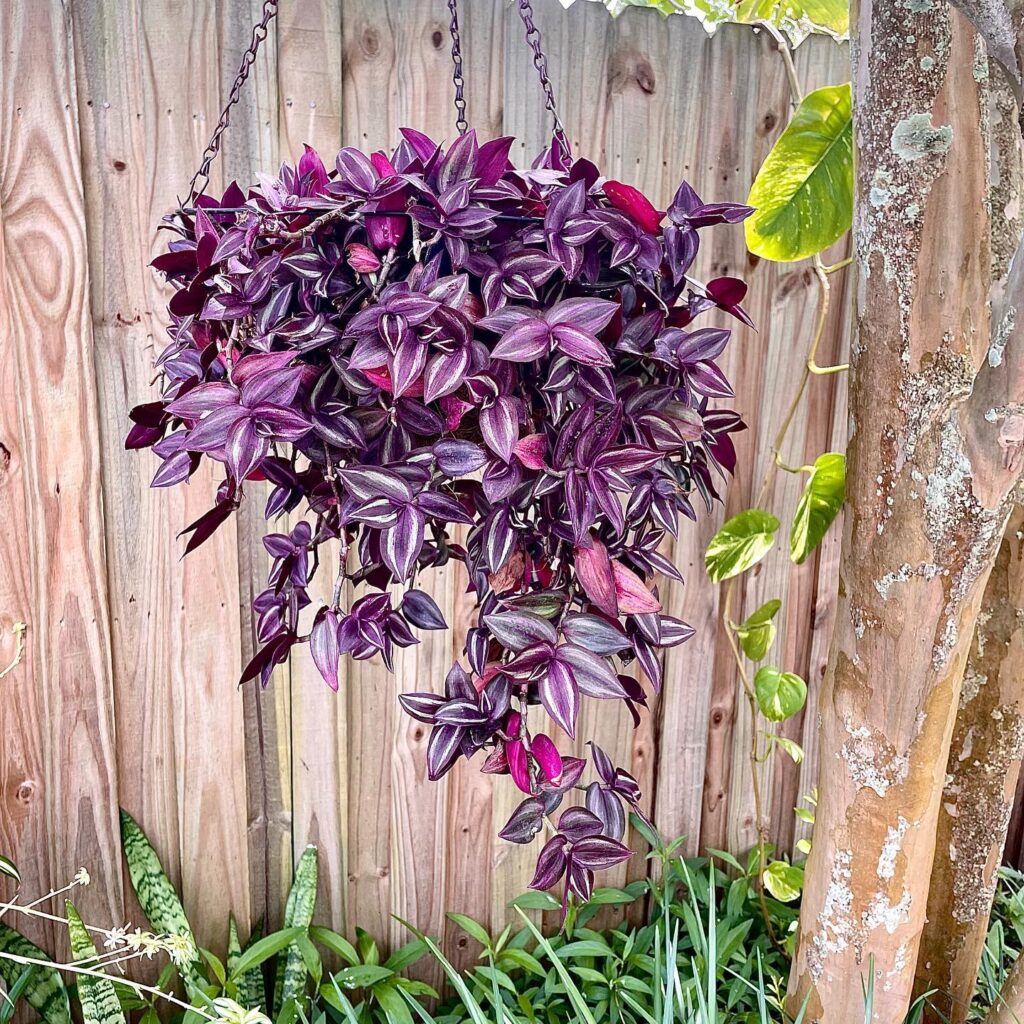
The most commonly grown plant species from the Tradescantia family, the stunning Tradescantia zebrina, has dark green leaves with shiny silver stripes and a purple to magenta reverse.
The plant is called Red Gem because there aren’t many plants that Mother Nature has endowed with so many benefits: eye-catching magenta to dark red colors, including almost metallic shiny bronze tones, graceful cascading lush growth, easy propagation, and specific growing conditions.
Tradescantia zebrina plants can withstand several hours of the full sun outside and filtered light or indirect light indoors.
The striped Wandering jew plants, Tradescantia zebrina, thrive in almost any type of soil as long as it is well-drained and does not retain moisture for a long time, endangering the root from rotting.
This flowering Inch plant produces small white flowers on the top of the stems during the summer months.
You can grow this plant outdoors in warmer climates; letting it crawl on the ground will create beautiful colorful islands.
It combines well with other plants in mixed containers, but it is equally beautiful as a stand-alone plant in a hanging basket.
7. Tradescantia Spathacea (Moses in the cradle)

Moses in the cradle is a common name for Tradescantia spathacea, the perennial plants native to Mexico, West Indies, Central America, and Guatemala. It is also known as Oyster plant, Moses-in-a-Boat, Boat Lily, Cradle Lily, and Moses-in-the-Bullrushes.
Although it belongs to the same family as Wandering jew plants, this is not a creeping species but an upright plant that forms a rosette of rainbow waxy lanceolate leaves with a light green face with white stripes and a purple reverse.
Prevalent are varieties such as Golden Oyster with green leaves and pale yellow stripes and the Tricolor variety, where cream-white, pink and green stripes alternate on the leaf’s surface.

Grown outdoors in a temperate climate, the plants reach up to three feet high since indoor plants are usually dwarf plants reaching a height of about six to twelve inches.
Moses in the cradle plant needs about six to eight hours of bright, indirect light, or it gets leggy.
Unlike other Tradescantia plants, the white flowers of this plant grow in the leaf axils in boat-like bracts, inspiring the plant’s name.
8. Tradescantia Chrysophylla (Baby Bunny Bellies’)

Another Wandering jew plant from South America, Baby Bunny Bellies’, is a lovely plant with monochromatic dark green leaves with smooth form and silky purple backs.
The plant prefers bright light and moderate watering regimen, but due to the monochrome dark green leaves that contain a lot of chlorophyll, it copes well with places with less lighting.
This small-leaf plant can grow from four to eight inches in height, and hanging stems in hanging baskets can grow up to two feet in length, gracefully descending over the pot’s edge.
9. Tradescantia Fluminensis Tricolor
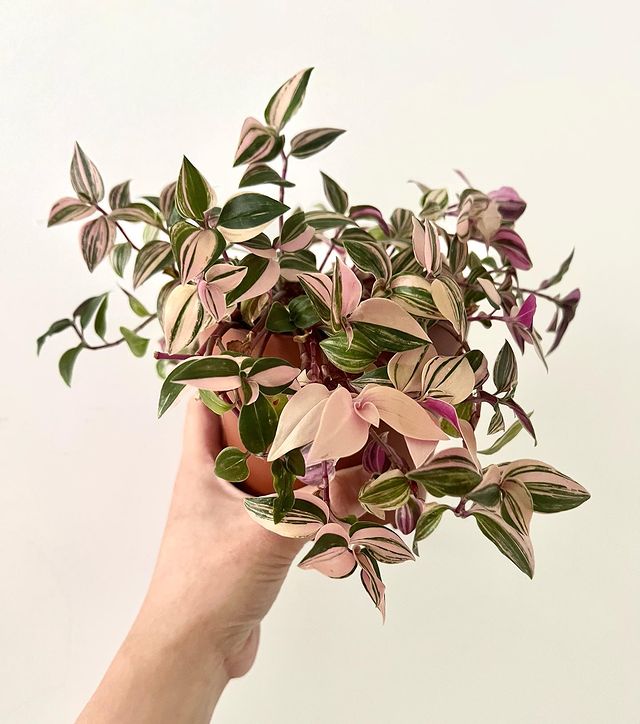
As its name suggests, this beautiful Tradescantia plant has leaves colored in white, pink, and green with purple undersides.
It is sometimes difficult to determine which color is the primary color of a leaf plate because surfaces, stains, and lines mix in almost equal proportions!
The plant belongs to the group of so-called small-leaved Tradescantia because its foliage is smaller than the leaves of other tradescantia plants, reaching up to two inches.
Also, the stems are thinner and gentler, so the whole plant has an airy, lacy, and filigree look.
RELATED: Monstera pinnatipartita: The Best Care, Propagation, and Watering Guide You Need
10. Tradescantia Adersonia (Blushing Bride)

If it seems that it is not easy to distinguish Tradescantia, especially those with a similar pattern, you will not have identification problems with this plant!
Tradescantia Blushing bride has a unique pattern in which the leaves are horizontally colored in pink along the stem and dark green in the other half of the leaf.
Moreover, new leaves are usually completely pink and get a green tint only when fully developed..
If you want the maximum effect, prune the plant regularly to have a full compact shape and keep it in a very bright place since lack of light causes losing pink color.
Frequently Asked Questions
Is Tradescantia Virginiana a Wandering jew plant?
Tradescantia virginiana or Spider lily belongs to the genus Tradescantia. Still, unlike Wandering jew plants, it is not a creeper but a rosette-forming garden perennial with narrow and long banded leaves and purple-blue flowers. It is resistant to cold and overwintering in the soil in continental areas.
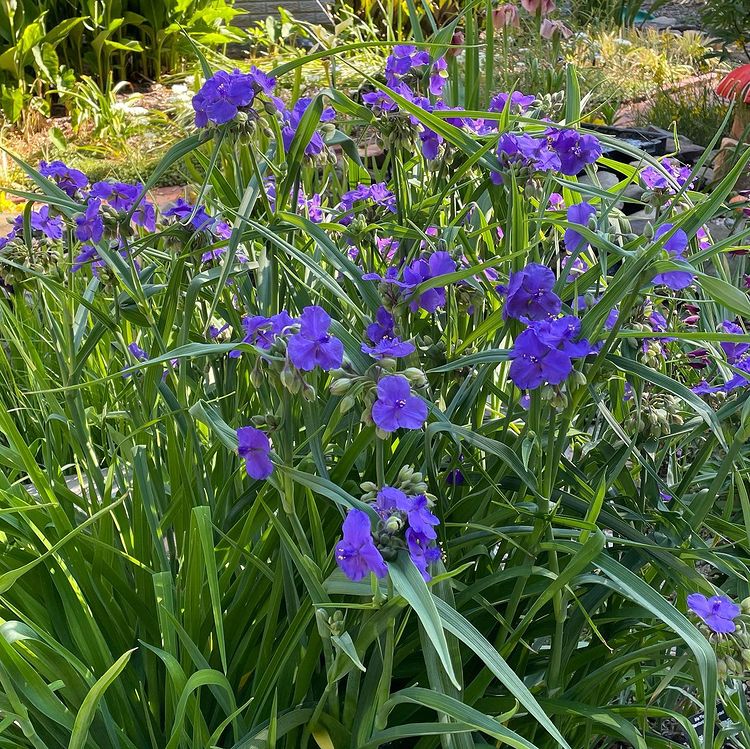
Should I prune my Spiderwort?
To prevent the plant from becoming leggy and messy, shorten its stems that are too long. The new growth appears shortly after creating the fuller bushy-shaped plant. You could pinch the tops at any time, but the best time for radical pruning is the end of the growing season in fall.
Is Tradescantia toxic?
The plant sap contains toxic substances that can cause digestive problems in humans and pets. Contacting the skin causes allergic reactions or irritations, so it is better to wear gloves when handling this plant!
Can Tradescantia be grown in water?
Tradescantia can also be grown in water as a hydroculture as long as the water is clean and does not contain organic material prone to rot.
Editor’s Recommendations:
Peperomia Hope: A Complete and Concise Care, Propagation, and Watering Guide
Philodendron Rojo Congo: The Best Care, Propagation, and Watering Guide You Need
Alocasia wentii: The #1 Care, Watering, and Propagation Guide







